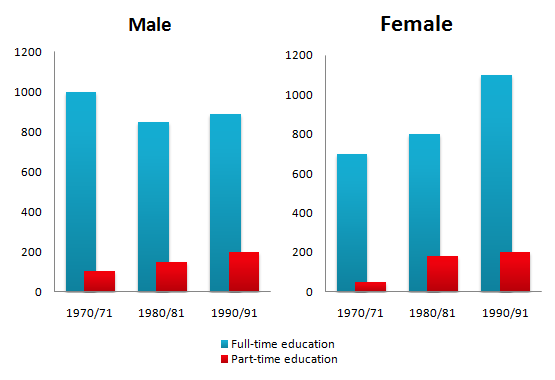The chart below shows the number of men and women in further education in Britain in three periods and whether they were studying full-time or part-time. Summarise the information by selecting and reporting the main features, and make comparisons where relevant.
The render bar charts enumerate how many male and female learners completed further education either Part-time or Full time in Britain in three different times, namely, 1970/71, 1980/81 and 1990/91.
Overall, it is crystal and clear that in both gender categories, the number of Full-time educational students number was far bigger than Part-time. Additionally, female numbers for further education has surged.
For males, in 1970/71, precisely 1000 students were learning Full-time which declined by roughly 140 students after two decades although, before that in 1980/81 had the least number of student in full-time education. Furthermore, only 80 students were in Part-time education in 1970/71. This number grew 40 students per decade, from 80 to 200 male students in Part-time education.
For females, the number of students in Full-time education was 150 in 1970,/71 less than male students in this time period. Later learners number increased in 1980/81 and 1990/91 it was 800 and 1100 respectively, last year’s numbers were 100 students more as compared to male in starting time. Part-time education was not popular in 1970/71. Thus, the female number was below 15. However, it accelerated to 180 in 1980/81. In 1990/91 enrolled stunts numbers were same as the male had in this year.
Follow Us on IELTSDATA Twitter
Also read: The chart below shows the places visited by different people living in Canada
